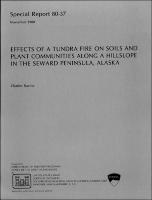Please use this identifier to cite or link to this item:
https://hdl.handle.net/11681/12068| Title: | Effects of a tundra fire on soils and plant communities along a hillslope in the Seward Peninsula, Alaska |
| Authors: | Racine, Charles H. |
| Keywords: | Fire ecology Tundra ecology Tundras Seward Peninsula, Alaska Vegetation Vegetation dynamics Revegetation Cold regions Ecosystems Fires Permafrost Frozen soils Frozen ground Wilderness EPOLAR |
| Publisher: | Cold Regions Research and Engineering Laboratory (U.S.) Engineer Research and Development Center (U.S.) |
| Series/Report no.: | Special report (Cold Regions Research and Engineering Laboratory (U.S.)) ; 80-37. |
| Description: | Special Report Abstract: During summer 1977, wildfires burned extensive areas of low arctic tundra in the Seward Peninsula, Alaska. The present study was initiated in July 1978 to determine the effects of these fires on tundra soils and vegetation. Nine 10- x 1-m permanent transects were established at regular intervals along the topographic gradient of a burned hillslope in the central Seward Peninsula near Imuruk Lake. Soil characteristics and plant species density and cover were determined in each of the 90 1- x 1-m plots on this slope during July of both 1978 and 1979. Soils and vegetation had been quantitatively sampled on this slope in 1973, thereby providing pre-fire comparisons; a sedge tussock-shrub tundra community with mud circles occupied the poorly drained footslope and a birch and ericaceous shrub tundra community with elongate turf-banked frost boils had developed on the moderately well drained backslope. The broad, poorly-drained summit was occupied by sedge-shrub tundra with low-centered polygons. The severity of burning in July 1977 varied along this slope with moderate to heavy burning of the birch and ericaceous shrub tundra and light to moderate burning of the sedge tussock-shrub tundra and sedge-shrub tundra communities. Post-fire (1978 and 1979) changes in plant cover, species composition and soil thaw depths are shown to vary with position on the slope and burning severity. The relationship of these changes to natural succession in the absence of fire is discussed. |
| Rights: | Approved for public release; distribution is unlimited. |
| URI: | http://hdl.handle.net/11681/12068 |
| Appears in Collections: | Special Report |
Files in This Item:
| File | Description | Size | Format | |
|---|---|---|---|---|
| SR-80-37.pdf | 18.12 MB | Adobe PDF |  View/Open |